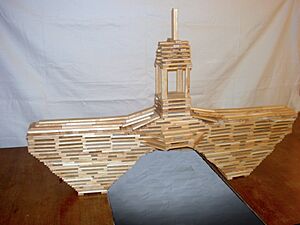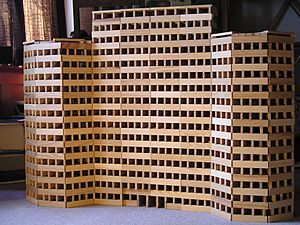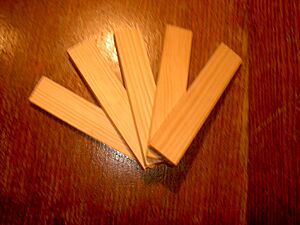Kapla facts for kids
Kapla is a fun construction set that both kids and adults can enjoy. It's made up of many identical wooden planks. These planks are special because they have a unique size ratio: 15 parts long, 3 parts wide, and 1 part thick. This special ratio helps you build things like roofs, floors, and even doorways. What's really cool is that you don't need any glue or screws to hold your creations together! Kapla builds are known for being super stable just by balancing the planks.
Contents
What Does "Kapla" Mean?
The name "KAPLA" comes from a Dutch phrase, "kabouter plankjes." This means "Gnome Planks." It's a cute name for these small, magical building blocks!
How Kapla Started
KAPLA was invented in 1987 by a Dutch person named Tom van der Bruggen. Tom loved art history and had always dreamed of building his own castle.
He found an old farm in the south of France and decided to turn it into his dream castle, complete with towers and fountains. To help him plan his castle, Tom used wooden blocks. But he soon realized that regular blocks weren't quite right for building certain parts, like the flat roofs or the beams above windows. This problem gave him the idea for the special Kapla planks!
Building with Kapla
Building with Kapla is all about balance and gravity. You don't need any glue, screws, or clips. Each plank is simply placed on top of another, and they stay in place because of their weight and how they are balanced.
There are three main ways you can use Kapla planks:
- You can lay them down flat.
- You can place them on their side.
- You can stand them up vertically.
You can also create different kinds of structures:
- You can pile them up like bricks, fitting them together.
- You can stack them to make things like spiral stairs.
Kapla is designed to let kids safely build, create, and experiment using their own amazing imaginations!
Types of Kapla Sets
Kapla planks are made from pine wood. You can find them in many different colors. They are sold in sets that range in size from 40 pieces all the way up to 1000 pieces!
Kapla for Learning and Art
KAPLA has created special educational art books. These books are made to give kids ideas and inspire them when they use their Kapla planks.
The books help children learn about geometry (shapes and sizes), physics (how things move and balance), and technology. They also introduce kids to the world of art, different forms, and volumes (how much space something takes up). These books are also meant to help children understand how unique and challenging building can be.




